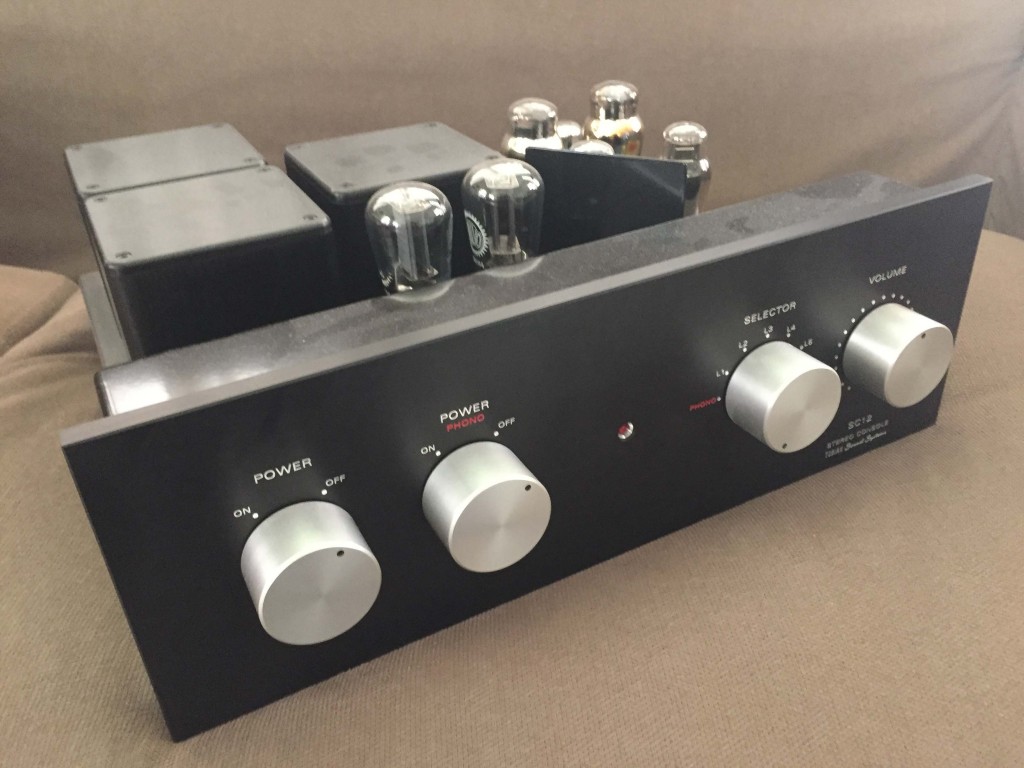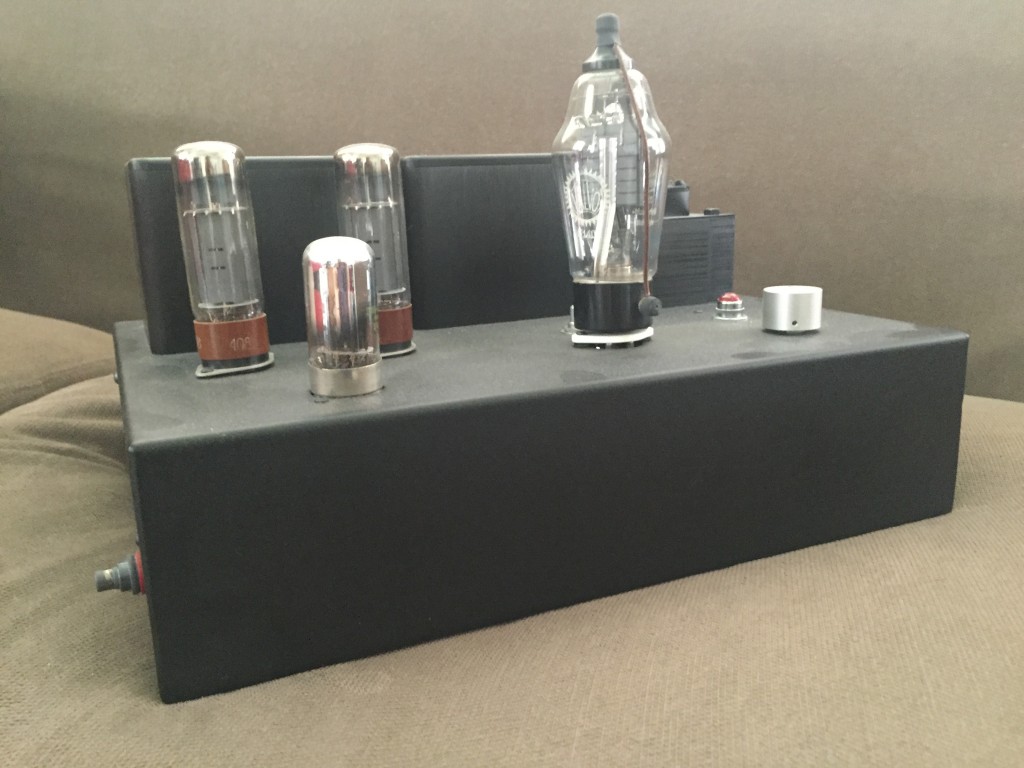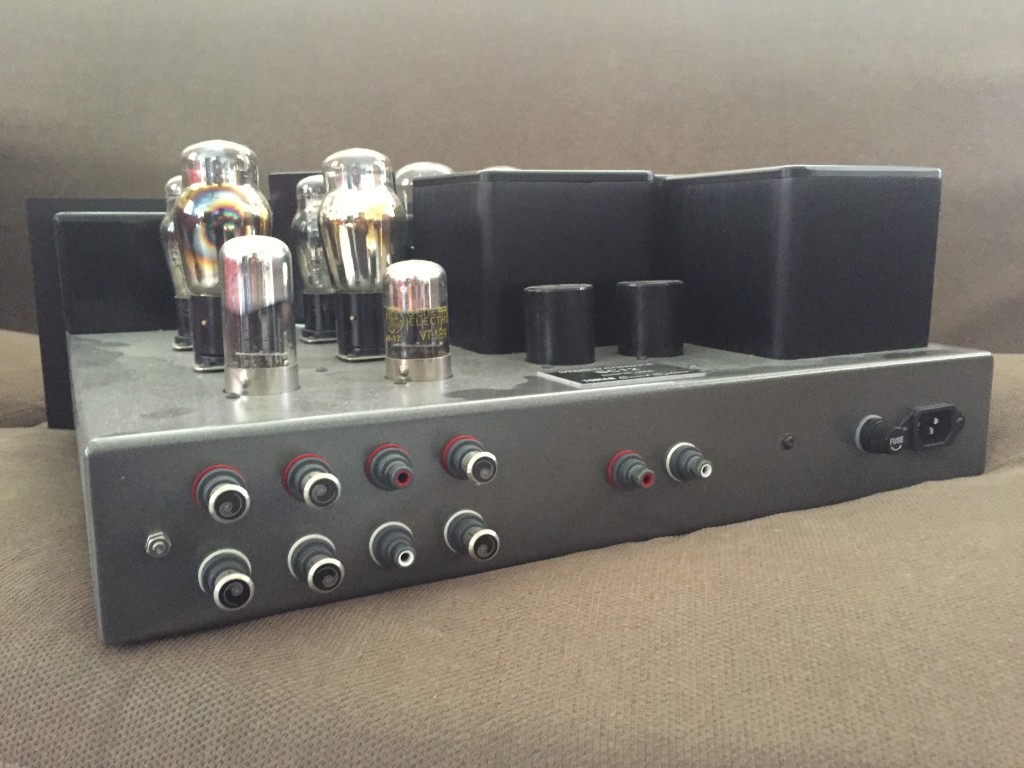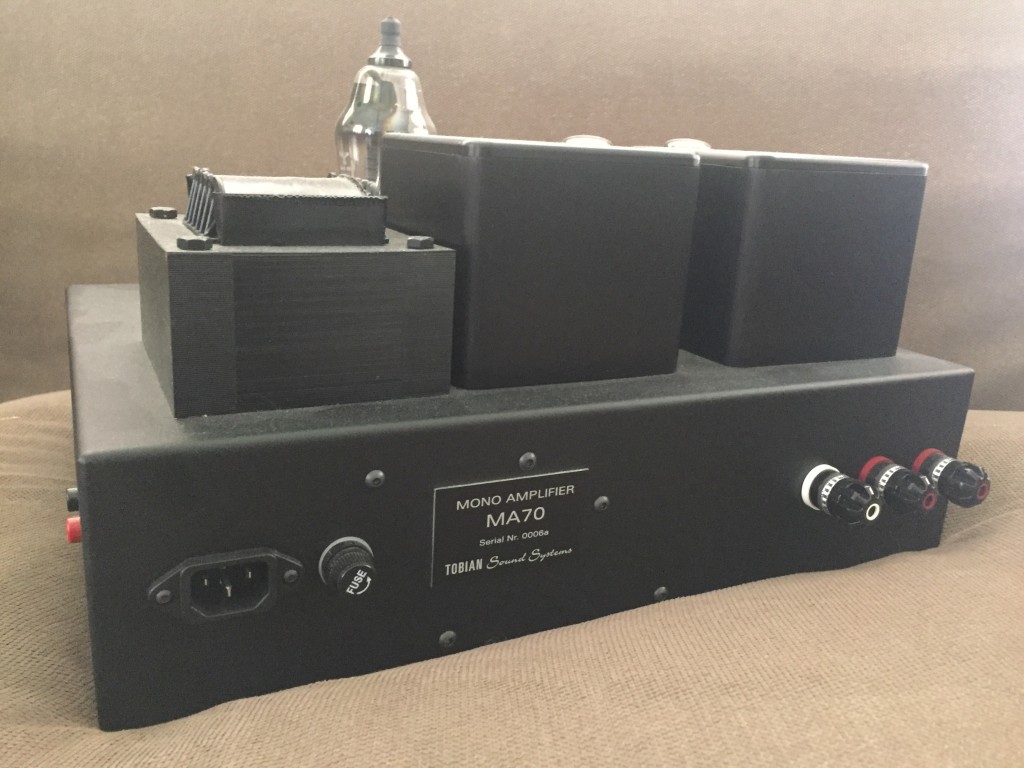Article by WL Low
I was mighty impressed with the sound quality Tobian DAC T9. Yes, it cost a bomb but it also sounds like a million bucks worth, there’s no like it or not here, only love it will do!
Now it’s the time to slip in Tobian’s Stereo Console SC 12, which is a pre amp with built in switch-able MM phono stage, and Push Pull Mono Tube Amp MA 70, which as it’s name suggest, is a pair of monoblock tube power amp with push pull topology.

Again, both item’s build quality are hard to fault, except that like the Tobian T9, have a very spartan look and hand made quality feel to them. The SC 12 pre amp is the more interesting one, only because it has four silver finished rotary knobs sitting in front of a black anodized aluminium face plate. The back panel of the SC 12 allows 4 pairs of RCA inputs and 1 pair of MM phono stage input. There is only a single pair of RCA output, and an IEC power inlet making up the rest of the rear panel.

The MA 70 power amp is truly plain Jane, except with a single ON/Off silver rotary knob on the top panel. There’s nothing at the four sides, other than three speaker cable terminals for 8/16 ohms speaker loading and an IEC power inlet on the back panel and a WBT sourced single end RCA socket on the left panel. The review sample of the MA 70 power amp came specified with following tube complements, EL34 – driver 6SN7, outputting 55W at 8/16 ohms. There are other tube complements to choose from which results is different levels of power output as listed in the technical specifications below. Both pre and power amps are armed with a variety of matched pair NOS tubes which predates the second World War that glows warm orange in the dark for nostalgic amusement. By the way, like some other esoteric Swiss Hi-Fi manufacturer, remote control option for the SC 12 is not available, in the interest of best sound quality.
Let’s describe the components with more detail, starting with the technical specs of the SC 12 pre amp:

Technical specifications
4 Line-inputs and phono-MM-input with tube rectification
Input switch Elma Hi-Grade made in Switzerland
Elma 47 step volume potentiometer with carbon comp resistors
Power transformer with galvanic splitter
Highest grade parts, custom made as well as Black Gate and GE capacitors
Phono MM with 6SN7GT and 40 Triode
Cabinet in V2A Steel electronically polished or finely enamel lacquered
Weight: 28 kg
Handmade in Hergiswil Lake Lucerne, Switzerland
lifetime warranty (less tubes)
And then with the technical specs of the MA 70 power amp:

Technical specifications
6550 / KT88 – driver 6SN7, 70W at 8/16 ohms
EL34 – driver 6SN7, 55W at 8/16 ohms
6L6GC – driver 6SN7, 40W at 8/16 ohms
VT52 / 50 Triode / 45 Triode, driver 6SN7 18W at 8/16 ohms
Power Transformer with galvanic splitter
Paper-in-oil capacitors optional
Output transformer hand wound with ultra-pure copper and galvanic splitter
Frequency Response: 5 Hz to 22.000 Hz
Signal-to-noise-ratio: > 90 db
Fixed bias, finely adjustable via potentiometer
Cabinet in V2A Steel, electronically polished
Dimensions: 40 x 22 x 30 cm (B x H x T)
Weight: 26 kg
Handmade in Hergiswil (Lake Lucerne) Switzerland
lifetime warranty (except tubes)
As a continuity review following the DAC T9, music files sourced from my resident Bryston BDP-1 digital media player, the SC 12 pre amp and MA 70 power amp was slipped in to my system, replacing my trusty ol’ Pass Labs X-0.2 pre amp and a pair of Magnet Hyperion Reference power amp. Since all Tobian products are single ended by connection, which means I didn’t have the required interconnects for them, so Thomas Lim of O’Lagenda Café did the nice thing and borrowed me the Tobian interconnects as well. The Tobian interconnects are sober looking affairs(with the exceptional use of WBT Next-Gen RCA locking plugs terminated at both ends) which I’ve describe earlier during the DAC T9 review. I used my resident JPS In Wall power cord for the MA 70 mono blocks and the SC 12 pre amp. As usual the Vermouth Red Velvet powers the DAC T9 and PS Audio Statement SC powers the Bryston BDP-1 digital media player. There’s a reason why I made specific references to power cord used for each component which you’ll read about shortly.

I fired up the system, and was greeted with a totally noise free, and silent back ground. I was very surprised by the result, because I was actually expecting some hum, due to the way the RCA interconnects interweaving with the various power cords. This is one case where I did not get to practice cable dressing, due to the way the system is set up in my room and all the cables are the wrong lengths, mostly too long!
That means the Tobian pre-power amp combo have excellent noise rejection properties, even better than some big named tube amp manufacturer that uses balanced circuitry and connections. Now I am really impressed.
In high end Hi-Fi, the total lack of noise floor, always nearly wins the battle, pending tonal quality and dynamic range only. The Tobian system is as quiet as Hi-Fi equipment will ever come or go and being tube based, especially an EL34 power tube, will always laced the music with some degree of sweetness. Yes, I must confess to be a closet EL34 tube lover some what, but in this regard, Mr Gunther(Tobian owner and designer) has voiced the sound very judiciously to have just the right amount of everything, including some warmness in tonal quality, just the right touch of glow in the tonal colouration and shading, yet have the transient qualities and dynamic range of a well designed solid state power amp! Yes, this 55 watter can kick some ass indeed.
Then some of my audio buddies came over when they heard I’ve got some fine Swiss hifi in my room, they wondered how a pair of puny 55 watter mono block amp can satisfy my insatiable hunger for high volume playback levels, comparing to my pair of 250 watts solid state amp in bi-amp mode, pumping my resident PMC IB2i, which is not a very efficient speaker by the way, being rated at only 85db for sensitivity. Actually, as the review was being brokered upon, I asked Thomas Lim the very same question, can the MA 70 power do the job with my resident pair of speakers? Thomas very confidently answered, “without a doubt!” Anyway, I still had my doubts until the system was powered up.
Now I get back to the power cord issue which was highlighted earlier, I fired up the system, Thomas Lim was full of anticipation and ask me how it felt(sound wise)? I told him the system sounded a little slow, and described it’s like as if the bass was rhythmically slow and draggy to the whole musical proceedings. Great refined highs tough! Thomas called back a few minutes later, and said this “Mr Gunther advises to use a standard power cord sourced from a PC package, i.e. and computer grade power cord, for the DAC T9.” The theory Mr Gunther advised was that all those, thick gauge power cord I am using was over saturating the power supply of the whole system. By using a normal grade computer power cord in the DAC, which draws the least power, would make the biggest difference in the scheme of things. I did so accordingly and Mr Gunther was proven right! The sound did take a more balanced positive turn in terms of musicality. That slow draggy bass line gave way to a bouncier ‘on’ cue timing bass, but the naturally refined high frequency reproduction just remains as nice. The rest of the review is completed using this PC standard power cord in the DAC T9.
Just in case your were wondering, I used Vermouth Red Velvet speaker cable and jumpers between the MA 70 mono blocks(using the 8 ohm terminals) and the PMC speakers. So how does 55 watts sound compared to the 250 watts? Let’s face the reality, the MA 70 will never win the SPL contest in this scenario, it clicked just 94db in room sound pressure level, compared to my usual 104db using my resident system. I had achieved 94db in room SPL with the SC 12 volume control set at 3 o’clock, while I could physically push the volume knob further to 4 or 5 o’clock position, all would be in vain, as the sound would not get any louder, but it would start to fray at the edges of imaging and the mid range would lose it’s sweetness, highs turned edgy. So keep within it’s usable performance bandwidth to enjoy the music. Did I mentioned the volume knob has one of the smoothest, well oiled, tactile action that I’ve ever laid my fingers upon?
The Tobian system is after all priced for those who can appreciate and want to enjoy the finer things in life, and it’s in those finer areas of sound, that the Tobian system really shines, quality over quantity is the order of day. In all fairness, during it’s time with me, the Tobian system never bothered me with it’s lack of loudness, rather it impressed me with it’s warm(though never overly so), charming tonal colours, detailed texture and delicate harmonic shadings, yet always focusing on the musician’s instrument playing techniques to the fore. In short, I never missed what it could not do, but Tobian showed me another side of musical presentation, that most if at all, lesser Hi-Fi components have not done, or had forgotten about.
High frequencies are complete in their fast attack, slow decaying in to fluffy nothingness of dark air. The music is liquid in it’s presentation. Vocal reproduction(especially female’s) is the forte of the Tobian system, as would any respectable tube based audio system should do. Today’s tube amplification however, tends to dilute it’s tube flavor in the goal towards tonal neutrality and transparency. Tube design of the yore could verge too much in to colouration for today’s standards. The Tobian system strikes the balance just perfectly so. There’s enough warmness to keep things interesting, yet retaining the superb highly transparent nature as demanded by today’s hi-res digital music files. The mid range literally breaths as realistic as it gets. Playing female vocal like Taiwanese crooner Tsai Ching, one can really feel her absolute emotional devastation in the Lou Ge album(rumoured to be recorded just after her painful divorce). Some even say that she sounded that way on that particular album was that she caught the flu during the recording sessions! What ever happened, Lou Ge remains Tsai Ching’s best work to date and an evergreen Asian audiophile classic. This album is made all the more special, played back via the Tobian system, as all her breathing techniques, the throatiness of her raspy voice, fizzling with emotions of vulnerability and sadness are laid bare to be heard.
Bass lines can dive deep, strung strong, and punch of the kick drums are as good as any tube based or solid state amplification could ever be. Bass notes are articulate, with texture and woody harmonics when listening to double bass or the fret-less bass(which has a flabby, long tone signature), making easy to tell which bass instrument one is hearing.
With it’s highly transparent sound signature, high transient speed, listening to music which focus on the acoustic guitar is a pleasure, with crisp clarity, of each note strummed followed by the decay in to thin air is an experience to behold and tingles the ears. The realism can cause hair at the back o the neck to stand, or result in eargasm, with the right recording. Dynamic range is wide band and never short changed. Tobian system will playback every music genre with the same gusto and reverence. Excellent recordings will be rewarded with the best playback experience, but poorly recorded materials doesn’t mean we have suffer for fools as a listener. The Tobian system is still forgiving enough to allow us to enjoy poor pop/rock and even modern day for MP3 recordings.
The staging & imaging factor in the Tobian system is taken for granted being tube based system. It can project a big staging with life like scale imaging with jazz trio or quartet in intimate recording venues. Large scale orchestra recordings can still be projected effectively at a much reduced scale, within the limits of it’s volume operating bandwidth. No fault of the amplifiers, I must say. Remember that my resident speakers aren’t the best technical fit for these amps. Tobian’s own model 18H horn loaded speaker design rated at 101db sensitivity is the more likely perfect technical marriage here. Given the 18H speaker size and weight, it’s just not possible to review them in my little man cave. However, I’ve heard The full Tobian system(including the 18H speakers) blasting a full on orchestral spectacular at the O’Lagenda Café showroom so loudly, that I just choose left the room for some refreshments. No offence to the Tobian system in any way, I just needed a drink. 3 in 1 Café anyone? O’Lagenda makes some of the finest Hailam toast(with a generous spread of kaya & butter) to go with some Cafe’ Mocha by the way. Do check them out, if not for the Hi-Fi, at least for the munchies and coffee, near Sg Besi, KL. By the way, unlike the hifi prices at O’Lagenda Café, the munchies & refreshments are very affordably priced.
Mr Gunther has voiced the Tobian system so judiciously well balanced on all fronts of Hi-Fi parameter demands, and a little bit more, the humanizing factor of those very Hi-Fi quality that makes each performance matter to us, the listener. The Tobian system is special in that way that each listening session, brings about a new, undiscovered dimension to each musical performance, even on songs that you’ve heard all your life time, and taught you know every single note of it. It makes each listening session about rediscovering your favourite and not so familiar music a pleasure of eargasm, guaranteed(at least for me, it did just that). Every genre I thrown at the Tobian system, including rock, the system did just enough for me to rediscover the songs all over again. Playing hip hop & rap music are not Tobian’s strength though, as Victor Pheh who came over for a quick listen as he was setting up the Kronos Sparta turn table said, “Rich man don’t play those noise le!” I guess Victor’s got a point! I just hope Mr Gunther don’t get mad at me for playing those offending tunes(with a sticker that says parental supervision required! on the album cover). Ha! Ha!
![Tobian[1]](http://av2day.com/wp-content/uploads/2016/01/Tobian1.jpg)
Like I’ve said in my review of the Tobian DAC T9, the prices of the Tobian Hi-Fi equipment are strictly POA. The volatile MYR$ currency only makes thing more difficult at this point in time. However, suffice to say that I am indeed proud and perhaps a little lucky too, to have hosted a Hi-Fi system costing well over half a million Ringgit(at point of review, for all 3 Tobian components) in my little man cave. The Tobian system does qualify as “Big boy’s toys for the seriously wealthy” music lovers(who else?). Those looking for something shinier to impress the Jones, can look elsewhere please.
Tobian is sold by O’Lagenda Café, contact
Thomas Lim at 012-4024441, or
Ah Hee at 010-7668049.
Article by WL Low
